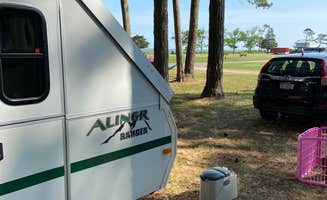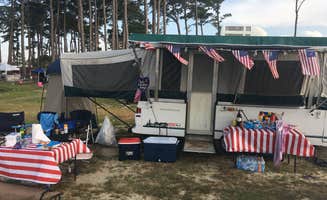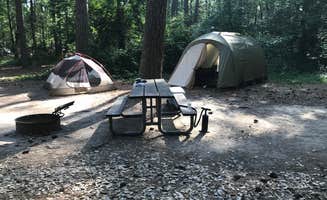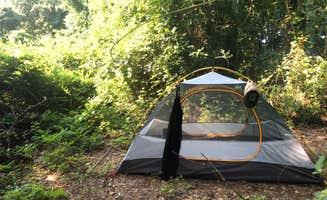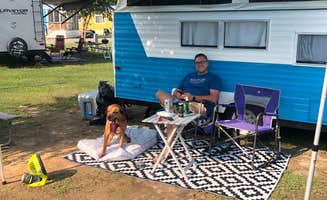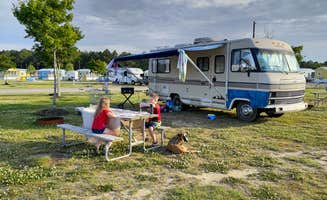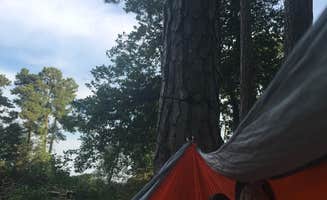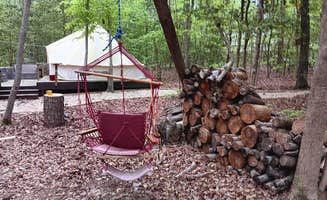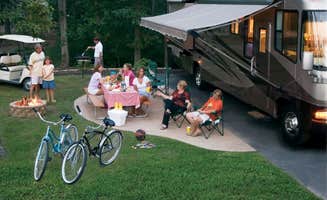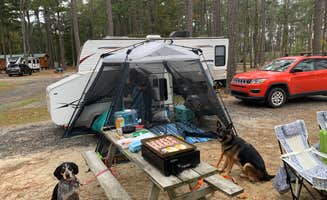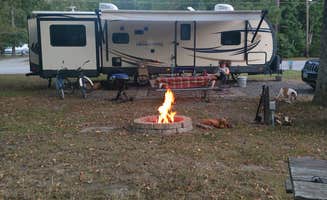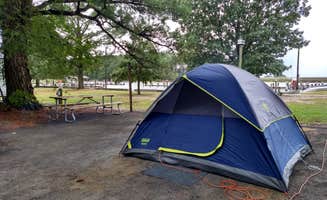Coastal camping near Nassawadox, Virginia offers direct access to both the Chesapeake Bay and Atlantic Ocean within a short drive. The flat, marshy terrain between these bodies of water creates unique camping conditions where campers often experience moderate to strong coastal breezes. Campsites in this region typically sit at elevations below 50 feet above sea level, with many areas subject to tidal influences.
What to do
Crabbing opportunities: At Thousand Trails Virginia Landing, visitors can catch both tiny crabs in the mud flats and blue crabs along the shoreline. "My kids loved catching tiny crabs in the mud every night," reports one camper who stayed at site 317 with full hookups. The activity is particularly good during evening hours when tides shift.
Kayaking water trails: Paddle through marked trails to explore the unique coastal ecosystem. "We used 2 of them that were wheel chair accessible," notes a visitor at Kiptopeke State Park Campground about the wooden boardwalk trails leading to different beach areas. The park's location provides calm waters ideal for beginner paddlers.
Wildlife viewing: Birdwatching is exceptional throughout the region's marshlands. "The scenery is amazing, especially at dusk and dawn," explains a visitor to Virginia Landing. Morning hours typically offer the best wildlife viewing with less boat traffic on the water. The Eastern Shore acts as a major flyway for migratory birds during spring and fall seasons.
What campers like
Beach variety: Cherrystone Family Camping Resort provides multiple water access options. "Offers so many activities for the entire family. The bath houses are very well maintained," writes one visitor. The campground features both protected bay beaches and swimming pools, giving families options based on weather conditions.
Sunset views: Many campers specifically mention the evening light as a highlight. "Amazing sunset views from the beach," notes a reviewer about Cherrystone. The western-facing Chesapeake Bay shorelines provide consistent sunset viewing opportunities year-round, with winter months offering earlier viewing times around 5:00 PM.
Clean facilities: First Landing State Park Campground receives high marks for maintenance. "The bathhouses and laundry were in amazing shape," notes one camper. Even during peak season, the campground maintains regular cleaning schedules with bathrooms typically serviced multiple times daily.
What you should know
Site layouts vary significantly: At Cape Charles / Chesapeake Bay KOA, "the spots were pretty tight, but we assumed as much." Sites closer to water tend to be more exposed with less privacy, while wooded sites offer more shade but less breeze.
Seasonal considerations: Most campgrounds operate with extended seasons but services change. "We were there just as it was reopening from the COVID crisis," noted a camper at Janes Island State Park, explaining that the marina and boat rentals were closed. Many waterfront facilities reduce hours or close completely during winter months.
Insect preparation: Biting flies can be problematic, especially on beaches. "Due to a lack of wind, flies were bad on the beach," notes a camper at Wisteria Beach Hideaway, recommending bringing an insect screen. Bug activity peaks from June through August, with early morning and evening being the worst times.
Tips for camping with families
Activity options: Cross Rip Camp offers equipment that eliminates the need to transport your own. "They provided kayaks, canoes, sailboats, beach chairs, bikes and so much more," writes one visitor. This smaller campground provides a less crowded alternative to larger resorts.
Pool alternatives: When beaches are windy or buggy, pools provide reliable water play. "Cherrystone has 5 swimming pools, very clean and well maintained. It has mini golf and paddleboats," notes a reviewer. Most pools operate from Memorial Day through Labor Day with limited hours.
Spacing considerations: Family groups should consider site selection carefully. "The camper spaces are perfect, not too close to your neighbor," explains a visitor to Cherrystone. Corner sites and end-of-loop locations typically offer more space for multiple tents and gathering areas.
Tips from RVers
Site positioning: At Virginia Landing, "We missed the shade a lot, but the evening breeze off the bay made up for it." RVers should consider seasonal sun patterns when selecting sites, as summer afternoon sun can make western-facing sites uncomfortably hot.
Hookup limitations: Several campgrounds offer partial hookups only. "Easy access to fresh water spigots sprinkled throughout the sites," notes a Janes Island visitor, though the park has "no water or sewer hook ups, but dump and water station is clean and close." Most campgrounds limit generator use to specific hours.
Maneuvering challenges: Site access varies across campgrounds. One visitor to Janes Island explained, "We weren't a huge fan of our site, site 50, because it was difficult to get into and it backed up to the marina. We basically had to do a u-turn in reverse with our 30ft travel trailer which wasn't the easiest." Larger RVs should call ahead to verify site dimensions.


